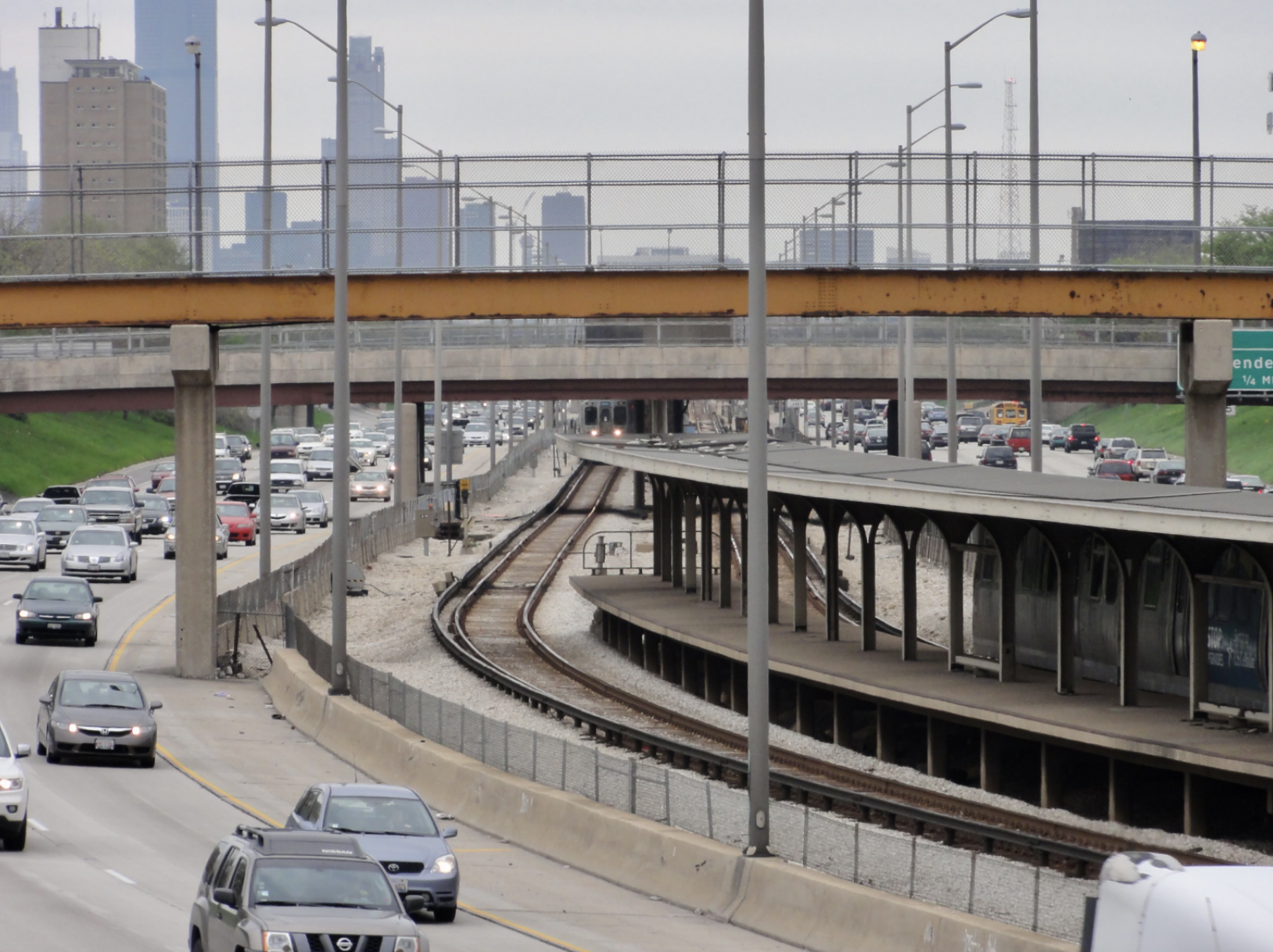Good News: IDOT Reconsiders Trading Car Lanes for Bus Lanes on the Drive
2:00 PM CST on December 9, 2016
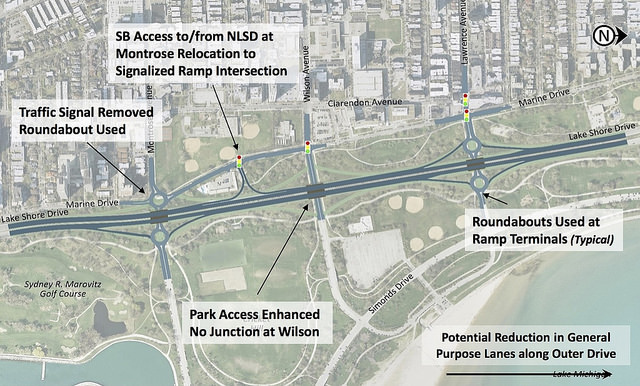
The proposal to use roundabouts to manage traffic coming off the drive would create hazards for pedestrians, cyclists, and people with visual impairments. Image: IDOT
On a cold afternoon earlier this month, almost a year after the Illinois Department of Transportation held a hearing to update the public on the “Redefine the Drive” project to rebuild North Lake Shore Drive, IDOT hosted another community meeting to discuss design alternatives. While it’s encouraging to see the state proposing a somewhat less car-centric version of the shoreline highway, their plans still leave a lot to be desired.
The hearing started out with a quick update work to create separate paths for pedestrians and cyclists on the Lakefront Trail. Work on building a bike-only “commuter trail” on the South Side between 31st and 51st is progressing faster than originally anticipated, and there will be hearings about doing a similar project on the North Side next year. In fact, the North Side path separation work could be completed years ahead the North LSD reconstruction.
Next the discussion turned to the highway reconstruction. Residents have submitted over 1,200 ideas for improving Lake Shore Drive by various means. IDOT has already rejected many of these suggestions due to cost, as well as concerns about reducing so-called “Level of Service,” i.e. a measure of unimpeded traffic flow for drivers.
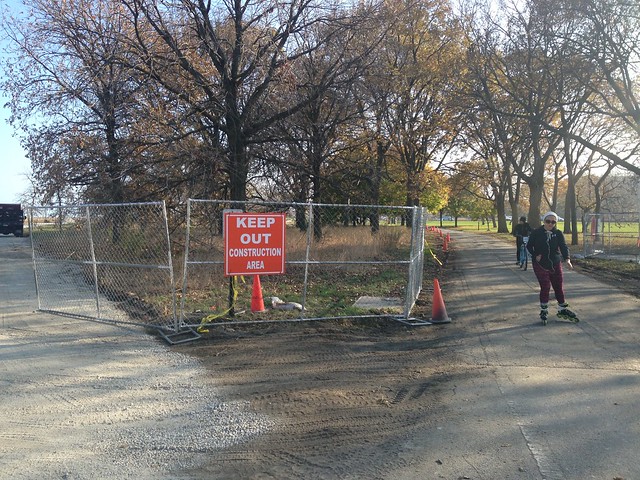
Several ideas for tunnels and/or causeways (roads on an embankment above a body of water) were scrapped due to expense. These would have involved either digging an express tunnel under existing North Lake Shore or building a massive tunnel or causeway bypass extending deep into the lake.
The state also rejected proposals to build a light rail line as part of the reconstruction (along with any hope of heavy rail in the future) due to cost. While no map was provided, an IDOT official did mention they had considered a plan for an 11-mile line that would have run from the McCormick Place convention center all the way to Loyola University in Rogers Park. The $4 billion price tag for the proposal was considered to be a deal-breaker.
Another proposal that the state threw out was to create at-grade intersections at Montrose, Wilson, and Lawrence, eliminating the viaducts. A possible motivation for this idea is the backlash from some local residents against homeless encampments in some of these underpasses. While IDOT is open to a possible reduction in lanes on the drive in this stretch due to relatively low traffic, they have already eliminated the possibility of at-grade intersections because the stoplights would delay motorists on the highway.
The proposals that IDOT hasn’t yet rejected include some very bus-friendly ideas. These include several managed lane options, as well as dedicated bus lanes. At the December 2015 meeting IDOT project and environmental studies section chief John Baczek indicated that adding dedicated bus lanes would probably require widening the highway, because it was unlikely existing car lanes would be converted to bus-only lanes. But, surprisingly, at the recent hearing there were signs that the department may be willing to convert two of the existing lanes after all.

That said, one idea that I wish they’d gone more into detail about was the proposal for an off-alignment" bus rapid transit route, which would be located between the Inner and Outer Drives in most areas. This was only shown only for a moment as a “conceptual schematic” without much detail – view map. It's possible this would be something like D.C.'s MetroWay or Ottawa's Transitway (now being partially converted to light rail) running in exclusive lanes for the entire route, with stations alongside the route.
The off-alignment scenario would have a distinct advantage over the concept that involve buses traveling on the existing drive because the BRT route’s proximity to the street grid could attract new riders and possibly take some pressure off the Red Line and other nearby bus routes. The only real criticism IDOT had against the idea at this stage was that the buses would be slower overall due to more frequent stops and at-grade street crossings.
The remaining bus alternatives involved bus lanes on either the shoulder or the center of the road with the latter having dedicated ramps on and off the drive. Some of the concept boards included stations in the middle of the drive at key locations. The managed lane options ranged from paid or unpaid high-occupancy toll lanes, an idea that Governor Rauner has proposed for the Stevenson Expressway, to reversible lanes like those on I-90/94.
There were several constants among the alternatives presented. IDOT seems dead-set on not only fixing the Oak Street S-curve but significantly expanding the drive’s junction at Chicago Avenue. Both of these changes would probably require the creation of new land via infill.
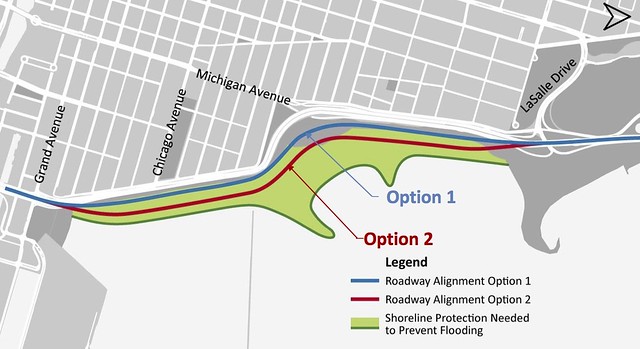
While these changes could potentially include the creation of new parkland, these proposals would morph LSD into something far more highway-like, with more elaborate grade-separation, than anywhere else on the drive, especially at the new Chicago Ave interchange. It seems that IDOT could do more to integrate these changes with the urban fabric. While potentially expensive, capping the Chicago Avenue junction could mitigate pedestrian and environmental impacts.
There were several comment periods during the hearing where attendees were able to voice their thoughts about the project. A representative from the Active Transportation Alliance said that while he was happy with the announced trail improvements, he urged IDOT to focus on reducing the overall number of cars on the drive by using demand management-based solutions.
Several people expressed concerns about potential impacts to existing parkland, everything from the possibility of reduced green space to worries about a reduction in the size of the median planters. In response IDOT officials said it’s too early in the study to know what specific impacts will materialize.
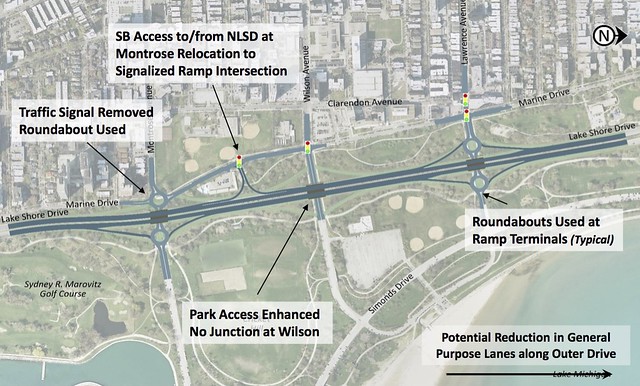
Roundabouts have been proposed as an alternative to stoplights and stop signs for managing traffic coming off the highway onto the east-west surface roads. However an attendee noted that these could be problematic for people with visual impairments. An IDOT rep agreed and said concerns about the impacts of roundabout on other pedestrians and bicyclists also cast doubt on whether this would be a viable option.
Afterwards I spoke with John Baczek about the changes to the project since last year's meeting. First I asked him why IDOT officials appear to have changed their stance and are now open to the possibility of swapping mixed-traffic lanes for dedicated bus lanes. He responded that IDOT has recently done new modeling using Chicago Metropolitan Agency for Planning data that showed it was possible to convert a travel lane for bus-only use without unduly slowing down car traffic. However, he said, this concept is still early in development, and more study is needed.
I also asked Baczek about IDOT’s ideas for fixing the messy Belmont interchange. He agreed that it is by far the hardest location to modify due to limited space and several difficult-to-move features, such as the statue of General Philip Sheridan on horseback at the intersection of Belmont and his namesake road. But he said they should have a design for the Belmont interchange to present the next public meeting. Hopefully that will take place before another year goes by.
You can check out the meeting materials on the project website. IDOT is still encouraging people to submit feedback on the site.
Did you appreciate this post? Support Streetsblog Chicago and donate.
Stay in touch
Sign up for our free newsletter
More from Streetsblog Chicago
Today’s Headlines for Thursday, April 18
Roger that! Streetsblog SF editor Roger Rudick offers constructive criticism of Chicago’s downtown bike network
"There were blocks that felt very safe and very secure," he said. "But then you're immediately – voom! – disgorged into three lanes of moving traffic with no protection."
City announces $2M federal grant to address harms caused by I-290 by improving walk/bike/transit access
The Mayor's Office says the money will fund "improvements for people walking and bicycling on existing streets and paths surrounding and crossing the corridor."


